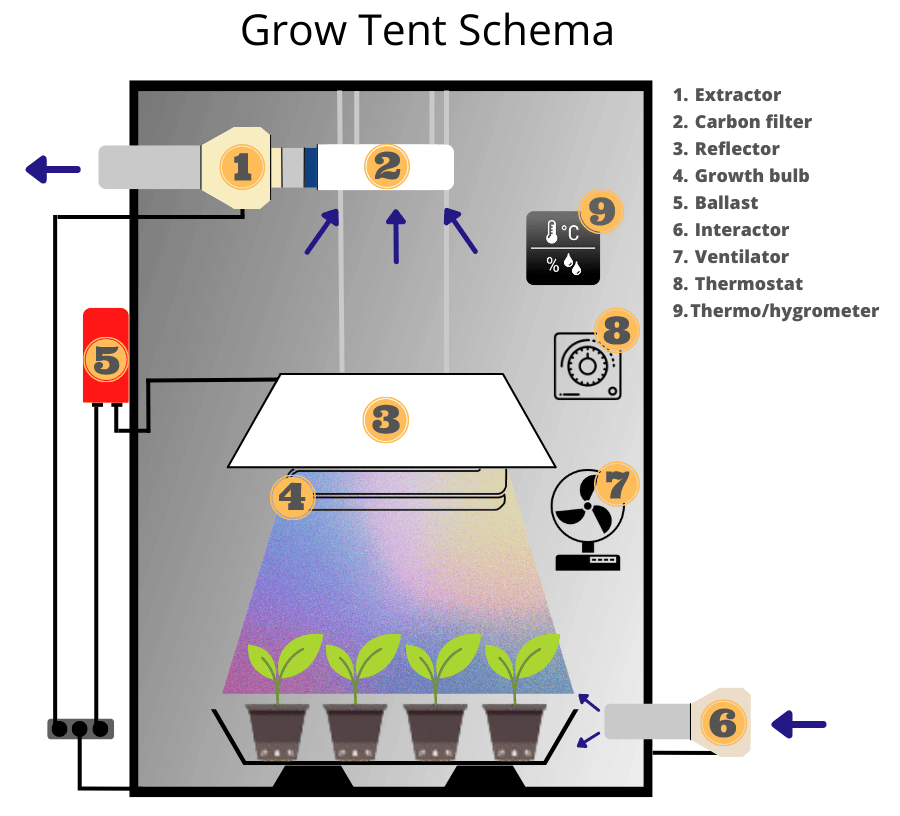Looking to get into hydroponics? A hydroponic bucket system may be the perfect way to start! In this epic guide, we’ll teach you everything you need to know about these systems – from product reviews to useful tips. By the time you finish reading this post, you’ll be an expert on growing plants in a bucket! Let’s get started.
I think hydroponics is a great way to garden indoors, and with a bucket system, it’s easier than ever.
The hydroponic growing might sound like a strange concept, but it simply means growing plants whose roots are submerged in water. DWC buckets are a great way to start out if you’re new to hydroponics – they’re simple to set up and maintain, and can be used for a variety of plants.

If you are interested in DIY Phosphorus Fertilizer you can also be interested in indoor hydroponic systems to help you easily start growing plants and grow tomatoes and other vegetables all year round. Our top articles: Our Picks for the 5 Grow Tent Kits, Picks for the 5 Aeroponics Systems, and Our Picks for the 5 best indoor vertical Garden, and Led Grow Lights for an indoor plant, and The Best Hydroponic Tower for Indoor Garden.
Comparison Chart of best DWC System (Hydro Bucket).
Best Choice  | PowerGrow Systems DWC Hydroponic Bucket Kit
| Check Price |
Also Great 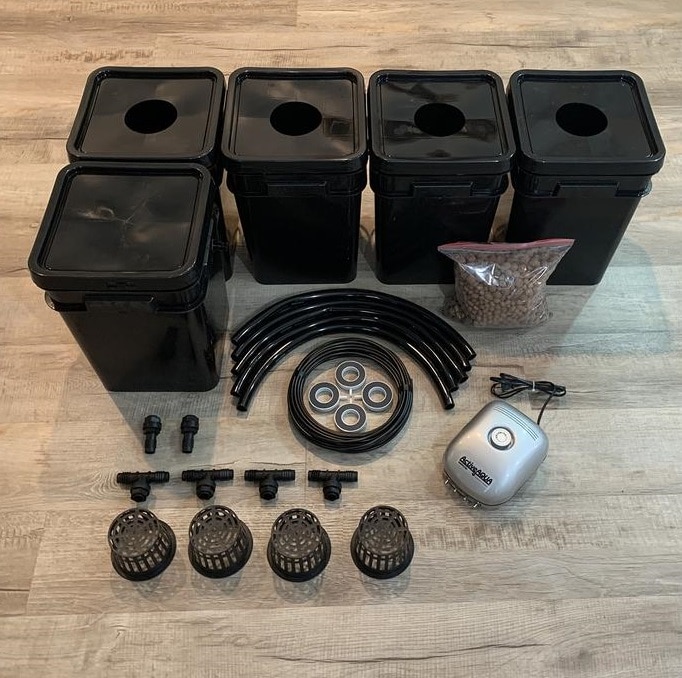 | Hydroponic Bubbler Bucket Grow Kit System
| Check Price |
Best Scaled  | Artisun Technology Dutch Bucket 10-pack
| Check Price |
Best Affordable  | Hydrofarm RS5GAL4SYS Root Spa 4
| Check Price |
Best Adventurous  | BayTec 5-Gallon Plastic Buckets, 6-Pack
| Check Price |
Plants are placed in a non-soil growth medium (like clay pebbles), which encourages the growth of a balanced root structure. Nutrient-infused water is circulated through the system, delivering ample oxygen.
But before you start growing hydroponically, you’ll need to pick the right system to start with. Here are our suggestions.
Our Picks for the 5 recommended Hydroponic Bucket Systems:
1. PowerGrow Systems Deep Water Culture Hydroponic Bubbler Bucket Kit – Best 5 Gallon Hydroponics Bucket System For Indoor Gardening
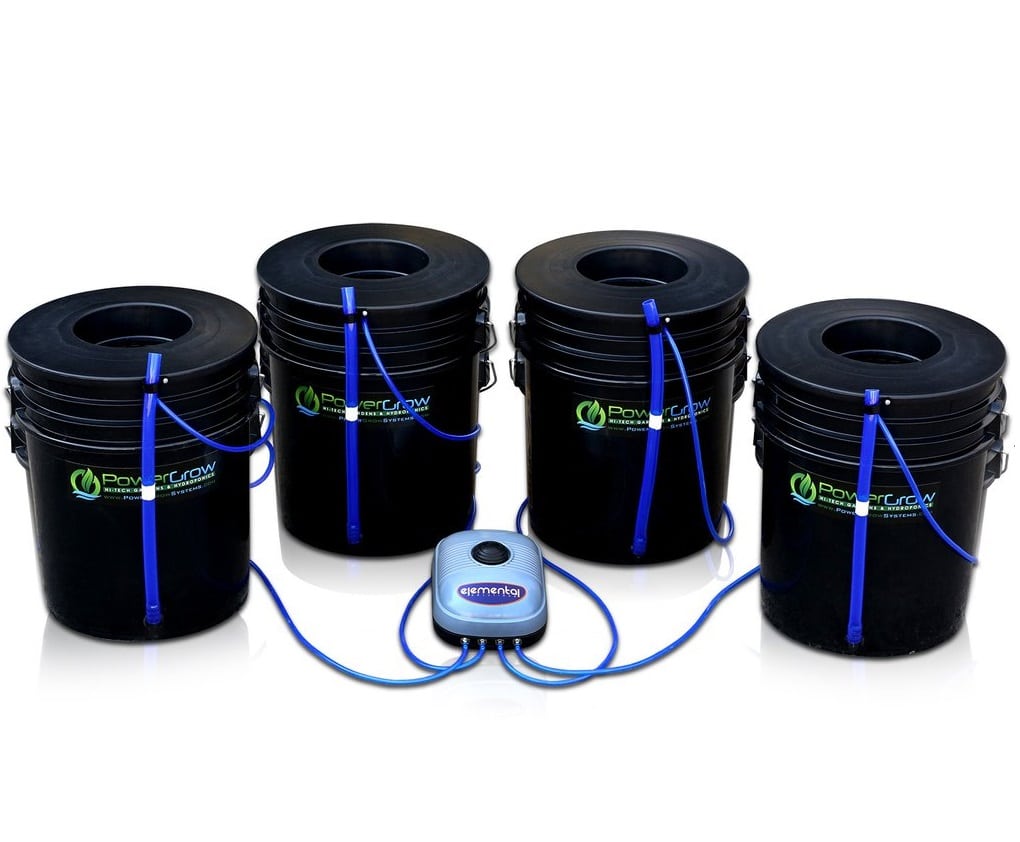
Performance of Bucket Grow System
This kit performs fairly well, and it has several convenience features. One is a water level indicator so you can make sure you top up water and nutrients as needed. Each bucket is also equipped with a drain, which is a feature you don’t often see in hydroponic kits. The pump that comes with the kit is a bit small at 6.5 W, so you may find that you want to upgrade to a larger pump for more efficient aeration.

Image 1: PowerGrow Hydroponic Systems DWC Buckets Kit example of placement in two different Grow Tents for growth and additionally the use of bags to keep moisture inside the bucket and dryness in the room.
Possible Reservations
The main reservation we have with this one is the pump – while it’s technically possible to use a pump of this size, many users have had to upgrade it to get enough circulation. Additionally, the tubing is somewhat stiff. This isn’t necessarily a huge deal, but it can make it harder to connect the system. We do still recommend this product. I can recommend this.
| Pros | Cons |
|---|---|
| This is a very affordable way to get into hydroponics | The included tubing is stiff and difficult to handle |
| It comes with everything you need except plants and a growing medium | |
| It comes with complete instructions | |
| And it also comes with a one-year warranty. Made in USA. |
2. Artisun Technology (DWC) Hydroponic Bubbler Bucket Grow Kit System – Best Easiest to Maintain Hydroponic Bucket Systems For Plants One Types

Performance
This is a system that performs well, and it has the added benefit of being easy to maintain. Each grow bucket is replenished by the reservoir as the plants consume water. This saves you from needing to top off each bucket individually. The pump also has an appropriate capacity for a setup of this size, so you likely won’t need to worry about it stopping working.
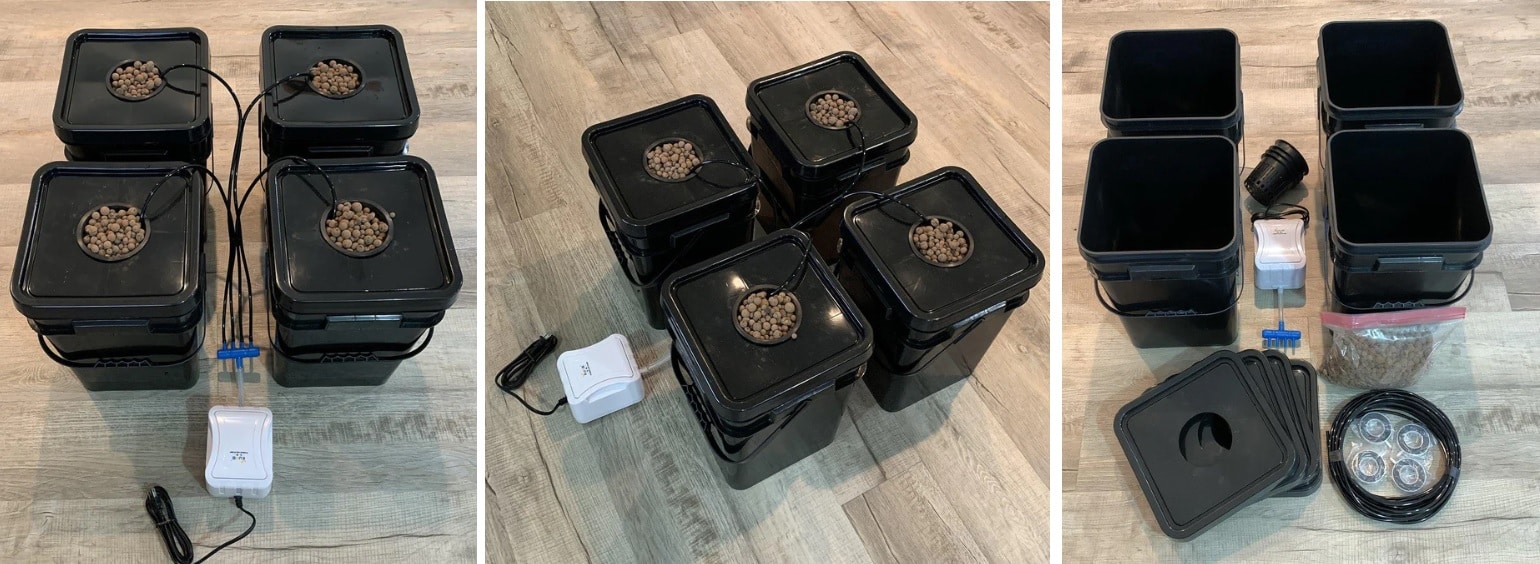
Image 2: Deep Water Culture DWC Hydroponic Growing System 5 Gallon 4 Bucket Bubbler Kit 3 steps to assembly, 30 minutes
Possible Reservations
We don’t have many reservations about this one – it’s fairly affordable, and it comes with almost all you need. However, a possible reservation is the size of the kit. Since you have an extra reservoir bucket, the setup takes up a good bit of space on the floor. Additionally, the buckets do not come with drains, which makes complete water changes difficult. We like the idea of a reservoir bucket, and we recommend this one.
| Pros | Cons |
|---|---|
| Included reservoir replenishes water daily | The fifth reservoir bucket may take up too much space |
| The included pump is strong enough to aerate each bucket | |
| It comes with clay pebbles, which is a great bonus | |
| Silicon washers make it almost impossible for water to spill from the buckets |
3. Artisun Technology Dutch Bucket 10-pack – Best Dutch Bucket Hydroponic System For A Professional Gardening also best rdwc system

Performance of hydroponic buckets
If you need a Dutch bucket for a hydroponic system, these ones perform well. While there’s no pump to evaluate, the hydroponic buckets themselves are made of sturdy plastic, and the drain fitting is very secure. This is vitally important, especially if your setup is an indoor one. If you choose these buckets, the manufacturer recommends a submersible pump that runs on 110V. Additionally, you can connect as many of these Dutch buckets if you want, making this set a good choice if you want to set up a large operation.

Image 3: Dutch buckets hydroponics Artisun Technology Dutch Bucket 10-pack.
Possible Drawbacks
If you are new to hydroponics, you may prefer to buy a complete kit. This way, you don’t have to worry about the right size tubing or the proper pump. Because this set only includes buckets, net pots, lids, and drain fittings, you will need to separately purchase tubing and a pump. If you have some experience with hydroponics, we recommend this kit.
| Pros | Cons |
|---|---|
| This is an affordable set, given that it includes 10 buckets | The lids of the buckets are somewhat flimsy and prone to cracks |
| The drain fittings fit securely, preventing leaks | This isn’t a complete starter kit, which may be an issue for those very new to hydroponics |
| It offers an option besides deep water culture | |
| This system is easy to expand upon if needed |
4. Hydrofarm RS5GAL4SYS Root Spa 4 – Best Affordable Hydroponic Bucket System for Larger Operations

Performance
These buckets perform well. The pump provides enough power to keep each bucket aerated, and all fittings are secure. However, for truly optimal aeration, you may want to invest in a more powerful pump. Setup is also fairly simple, which is ideal for those who aren’t too familiar with hydroponic systems.

Image 4: 4. Hydrofarm RS5GAL4SYS Root Spa 4 hydrobucket example of installation in a growth room, growing pumpkins and marrows all year round.
Possible Reservations
In many cases, purchasers of this set find that the product arrives missing critical pieces. However, the manufacturer will quickly send replacements if needed. Additionally, as is the case with some other hydroponic kits, the pump may not be strong enough for all growing setups. Still, we think this is a quality starter kit, and we recommend it. I can recommend this too.
| Pros | Cons |
|---|---|
| This is a fairly affordable way to get into hydroponics | In some cases, you may need a stronger pump |
| You don’t have to use air stones, which makes the setup simpler | These buckets are also not equipped with drains |
| Water indicators help you know when it’s time to top up the water | |
| Watertight seals reduce the risk of spills |
5. DIY Hydroponic System – Best Do It Yourself Hydroponic Bucket Systems For Adventurous Growers

5.1 BayTec 5-Gallon Plastic Buckets, 6-Pack
 BayTec 5-Gallon Plastic Buckets, 6-Pack
Check Price
BayTec 5-Gallon Plastic Buckets, 6-Pack
Check Price
5.2 Hydro Flow 3/4″ Rubber Grommets
 Hydro Flow 3/4″ Rubber Grommets
Check Price
Hydro Flow 3/4″ Rubber Grommets
Check Price
5.3 Hydrofarm AAPA15L Active Aqua Pump
 Hydrofarm AAPA15L Active Aqua Pump
Check Price
Hydrofarm AAPA15L Active Aqua Pump
Check Price
5.4 VIVOSUN Air Stones, 4×2
 VIVOSUN Air Stones, 4×2
Check Price
VIVOSUN Air Stones, 4×2
Check Price
5.5 Mother Earth HGC714112 Hydroton Original Expanded Clay Pebbles (leca)
 Mother Earth HGC714112 Hydroton Original Expanded Clay Pebbles
Check Price
Mother Earth HGC714112 Hydroton Original Expanded Clay Pebbles
Check Price
5.6 Deep Blue Professional ADB12296 Silicone Air Tubing
5.7 Viagrow V6ML-6 Wide Lip Mesh Bucket Net Pot
 Viagrow V6ML-6 Wide Lip Mesh Bucket Net Pot
Check Price
Viagrow V6ML-6 Wide Lip Mesh Bucket Net Pot
Check Price
| Pros | Cons |
|---|---|
| Making a set up yourself can be rewarding | This can be time-consuming, and if you don’t know what you’re doing, it’s easy to damage components |
| You can generally customize a DIY setup more easily | This method is almost twice as expensive as purchasing a pre-made kit |
| You can hand-pick each component | |
| DIY systems can sometimes be easier to expand |
Best Hydroponic Bucket System – Buyer’s Guide.
Tips Hydroponic Bucket System – DWC System
From my experience it follows, here are some tips for using a hydroponic bucket system or Deep Water Culture (DWC) system:
- Choose the right size container: DWC systems require a container that is large enough to support plant growth and hold enough nutrient solution. Consider the size of the plants you want to grow and choose a container that can accommodate them.
- Monitor pH and nutrient levels: DWC systems require precise pH and nutrient levels for optimal plant growth. Monitor these levels regularly and adjust as necessary.
- Provide adequate oxygenation: DWC systems require proper oxygenation to ensure that plant roots receive enough oxygen for healthy growth. Use an air pump and air stones to provide adequate oxygenation.
- Choose appropriate plants: DWC systems are suitable for a wide range of plants, but some may be better suited than others. Choose plants that have a compact growth habit and can tolerate a high moisture environment.
- Use a high-quality growing medium: DWC systems require a growing medium to support plant growth and anchor the roots. Use a high-quality medium such as hydroton, which provides good drainage and retains moisture.
- Control pests and diseases: Keep a close eye on your DWC system for signs of pests or diseases, such as root rot or algae growth. Use organic pest control methods or remove infected plants to prevent further spread.
- Maintain proper temperature and humidity: DWC systems are sensitive to changes in temperature and humidity. Make sure to maintain the proper temperature and humidity levels within your system for healthy plant growth.
By following these tips, you can successfully use a hydroponic bucket system or DWC system to grow healthy and bountiful plants.
When Were Hydroponics Invented? How Do They Work?
Hydroponics might sound like something out of the future, but this method of growing – cultivating plants with only water, nutrients, and a non-soil growth medium – has been around since ancient times. Babylon’s Hanging Gardens and China’s Floating Gardens are two notable examples.
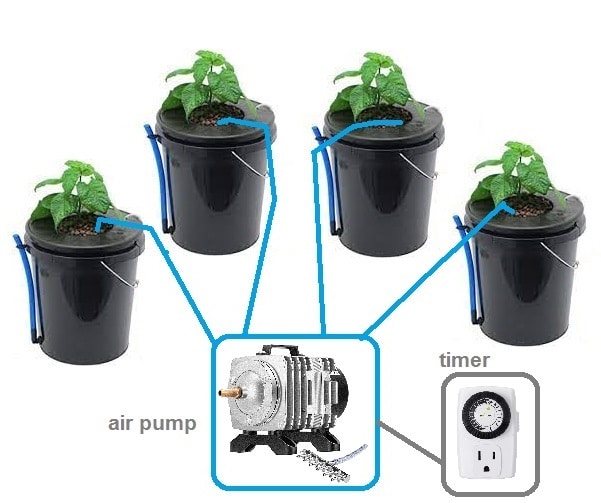
Hydroponic growing almost always results in plants that reach greater sizes. In many cases, it also drastically increases yields. This is because this method of growing lets growers control almost every aspect of a plant’s development. Nutrient solutions specific to each plant type ensure that each has what it needs to grow, and increased oxygenation speeds growth as well. In a hydroponic system, a plant’s roots don’t have to continuously expand to find more nutrients, so more energy will be directed into leaf, flower, and fruit growth.
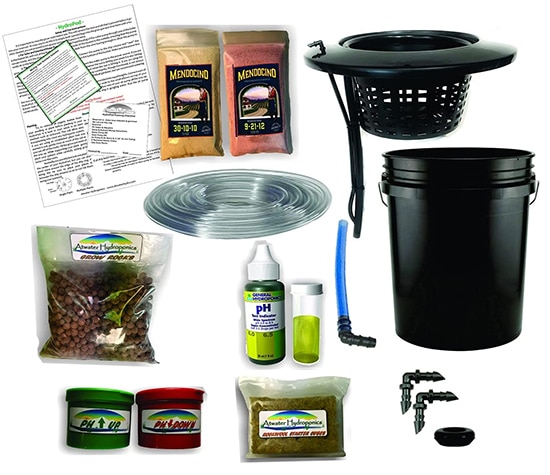 The Atwater HydroPod - Standard A/C Powered DWC/Recirculating Drip Hydroponic Garden System Kit
The Atwater HydroPod - Standard A/C Powered DWC/Recirculating Drip Hydroponic Garden System Kit
- Most efficient use of water compared to traditional gardening
- Dual outlet air pump, Nutrients are Included!
- Kit contains everything you need to start your own garden (minus plants and water!)
Also, i can recommend this article to read about How to Set Up Hydroponic Drip Systems.
What Types of Hydroponic Systems are There?
As the science of hydroponics has developed, numerous types of setups have emerged. Here’s a brief rundown of the different types and their advantages:
Deep Water Culture (DWC)
These systems are popular due to their affordability and ease of setup, making them a feasible option for home gardeners. Plants are suspended in water using net baskets, and the water is aerated with a pump and airstone. As these systems are low-maintenance, they are ideal for beginners. Considering their user-friendliness and ease of maintenance, we have primarily focused on these systems while selecting our top choices.
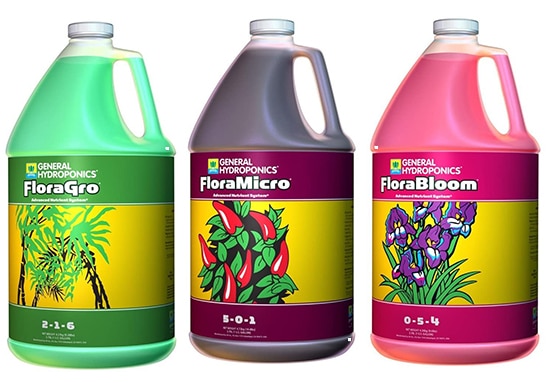 General Hydroponics Flora Grow, Bloom, Micro Combo Fertilizer, 1 gallon (Pack of 3)
General Hydroponics Flora Grow, Bloom, Micro Combo Fertilizer, 1 gallon (Pack of 3)
- Сomplete nutrient system
- Highly purified concentrates for maximum solubility
- NASAAntarctic research scientists choose flora series!
Drip Systems
Drip systems, as the name suggests, pump nutrient-rich water from a reservoir into a pipe that slowly drips onto each plant. Excess water circulates back to the reservoir. Because these systems recycle water, it’s important to very closely monitor water pH. These systems are easy to expand to start a larger growing operation. If you’re a home grower or new to hydroponics, setting up and maintaining a system like this can be incredibly challenging.
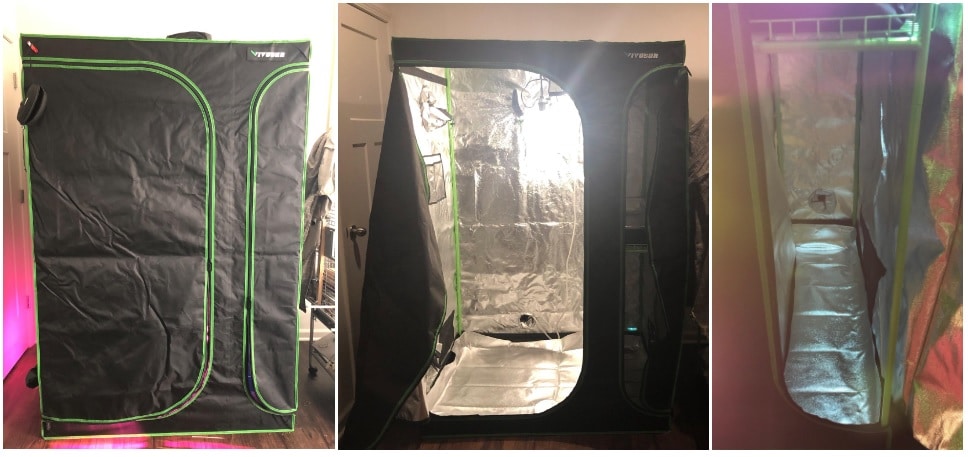
Image: Grow Ten Kits for hydroponics 5 gallon bucket from Vivosun.
Wick Systems
If you would prefer a hydroponic system that needs no electricity at all, you might like wick systems. These simple setups have plants in a tray of the growth medium, and that tray is suspended above a reservoir of water. Wicks made of rope, coconut fiber, or similar materials pull water from the tray and deliver it to the growth medium.
Nutrient Film Systems
In these systems, a pump continually circulates nutrient solution so it flows over the root tips of the plants. This system exposes the top parts of the roots so they receive plenty of oxygen. If the pump stops working, the plants can die very quickly, so it’s important to keep a careful eye on the system.
Ebb and Flow Systems
These systems may work well with certain types of plants. In these systems, the pump runs on a timer — at certain times, the growth medium is flooded with nutrient-rich water. At other times, it drains out. This type of system lets you customize when your plants are flooded and may take some practice. Once it’s mastered, this method can lead to impressive yields.
Aeroponics Systems
These are the most water-efficient systems, although they can be very expensive to set up. Plants are situated so their roots are suspended in air, and they are periodically misted with nutrient water. These setups are very space-efficient, making them a good choice for apartments and other smaller spaces.
What Are the Parts of a Hydroponic System?
If you’re new to hydroponics, you might want to purchase a kit. This way, you will have the tubing you need (pre-cut into required lengths), a pump, and all buckets and net pots you need. Still, it’s wise to get a good general idea of each part of the system and why it’s important.
Buckets
In most cases, experts recommend three-gallon to five-gallon buckets for deep water culture systems. This might seem surprising, but plant root structures can grow far outside of the net pot. A larger bucket also gives plenty of space for water and nutrients to circulate.
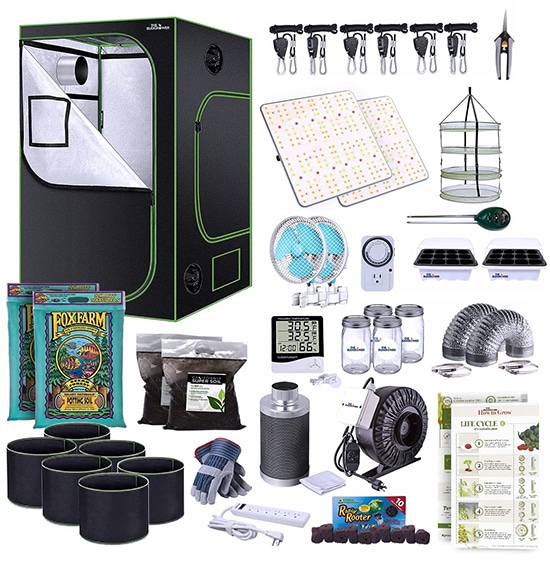 TheBudGrower Complete All-in-One Home Grow Solution 4x4x7ft- 2200W(2)
TheBudGrower Complete All-in-One Home Grow Solution 4x4x7ft- 2200W(2)
- LED lights specialty manufactured by VIVOSUN with Samsung LM301 diodes for FULL spectrum light
- The industries most durable grow tent – heavy duty 1680d oxford cloth
- Money & energy saving complete home grow tent kit
When purchasing buckets, it’s a good idea to make sure they include rubber or silicone washers. These provide seals around tubing connections and net pots, making it unlikely that anything will spill.
Pumps
When selecting a pump for your system, it’s necessary to make sure you have enough power. If a pump does not produce enough oxygen circulation, plants can drown in water. It’s best to have a pump that cycles one liter per minute of air for each gallon of nutrient water in your reservoir.
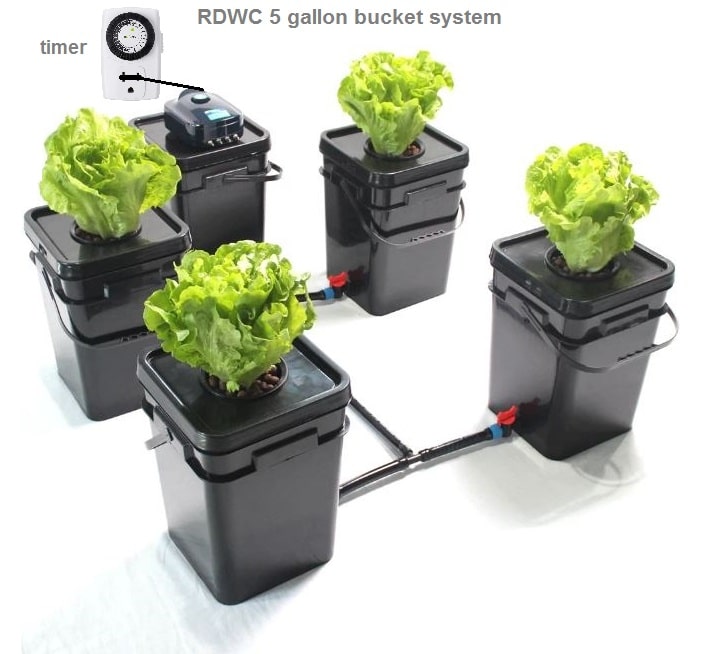
Tubing
Most tubing for hydroponics is made out of soft, flexible silicone. Although this might seem like an easy part of your system to select, there are some important considerations to make. Namely, most growers recommend black tubing. If your tubing is clear or otherwise allows light in, this may allow algae growth. Algae can cause problems for your plants, and it can start to clog the tubes in severe cases.
In all-inclusive kits, the manufacturer will pre-cut tubing to appropriate lengths. For a DIY system, you’ll need to purchase a larger length and cut it to needed specifications.
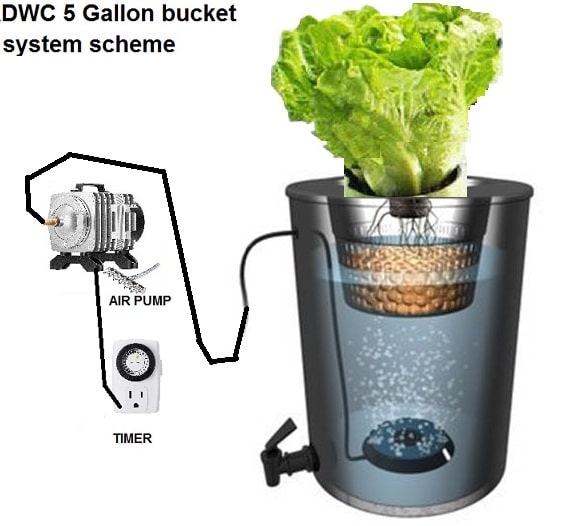
Net Pots
As the name suggests, net pots are simple, basket-like structures. They are designed to hold both seedlings and a growth medium. The growing plants’ roots can then extend out of the growth medium and through the sides of the net pots. The pots come in various sizes, and it’s recommended to make sure you have a seal around them to prevent leaks.

Air Stones
Oxygen is essential to plant growth. It encourages nutrient uptake and accelerates growth. It also kills off harmful pathogens that can kill plants. Because oxygen is so vital to growth, it needs to be constantly replenished in water. The air pump itself introduces a good bit of oxygen, but air stones ensure that tiny oxygen bubbles reach your system. These are much more easily dispersed, and they ensure that all oxygen is more evenly distributed.
Growth Medium
Many deep water culture kits let you choose your hydroponic growth medium. We think clay pebbles are an excellent choice. They are reusable, fairly pH-neutral, and encourage a balanced root structure. If you prefer, Rockwool, vermiculite, and other substrates can be used.
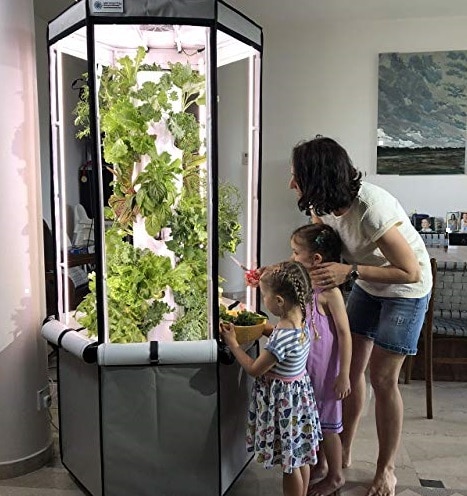
 Aerospring 27-Plant Vertical Hydroponics Indoor Growing System
Aerospring 27-Plant Vertical Hydroponics Indoor Growing System
- Easy to use aeroponic system for your home
- Fan - Grow Lettuce, Herbs, Veggies & Fruits
- Grow smart & eat healthy, 20 gallon water reservoir Grow Tent, LED Grow Lights
Final Thoughts
In summary, hydroponics is a rewarding hobby to get into – you can grow fresh food at home, and in many cases, your system will require minimal upkeep. And best of all, deep water culture systems tend to be inexpensive and fairly easy to set up. If you take your time, do your research, and pick a solid system to start with, you’ll be on your way to growing healthy plants in no time.
I can recommend this article to read about How To Measure Grow Light with A PAR Meter also in Grow Room.
Happy Growing!
